Toshiba Satellite L645D: Mobile AMD at 3GHz
by Dustin Sklavos on March 9, 2011 3:20 AM ESTMostly Portable
A point where AMD-based notebooks have traditionally suffered (with the notable exceptions of both Sony's EE34 and pretty much anything Fusion-based) is battery running time. Toshiba equips the L645D with a mediocre six-cell, 48Wh battery that may somewhat dampen the mobility of a notebook that's otherwise fairly portable.
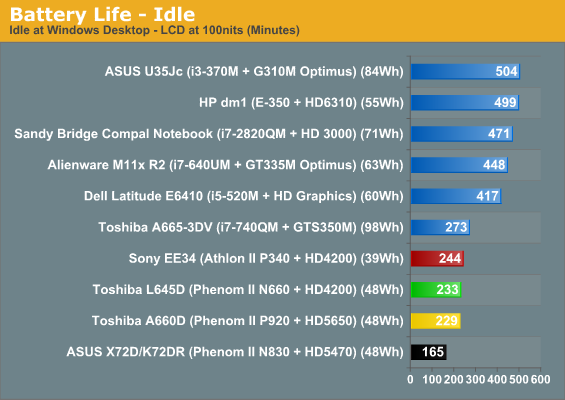
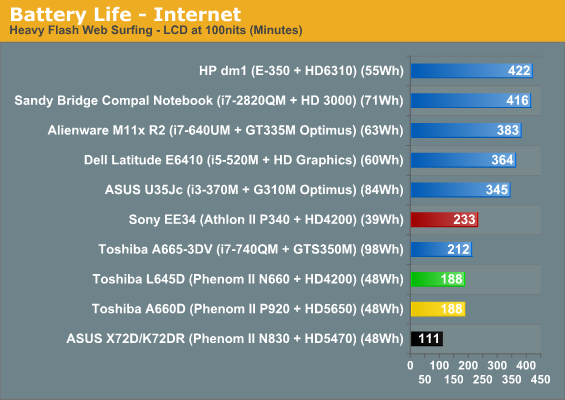
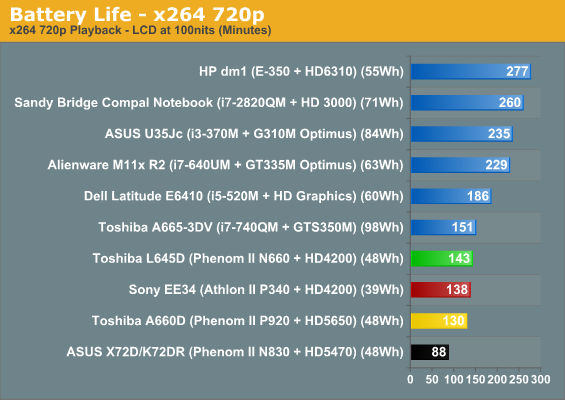
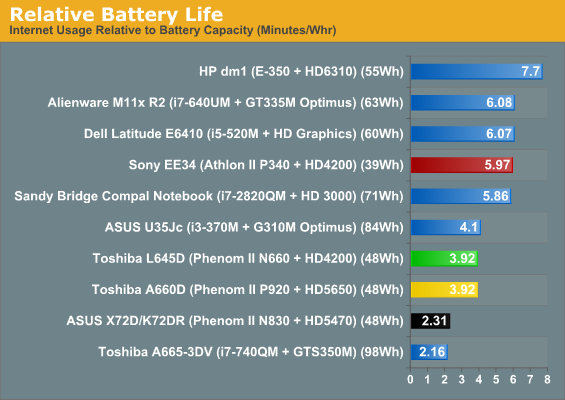
The relative battery life of the L645D isn't completely dire, but the Sony EE34's 25-watt processor runs roughshod over it. In practice, though, the L645D is still able to achieve three hours of useful running time surfing the internet. This is something Jarred's mentioned before and we've discussed at length: if you look at the running times of the Intel-based notebooks, you'll notice they're all equipped with much larger batteries. It seems like manufacturers almost deliberately cripple AMD-based notebooks.
We're not suggesting the L645D would offer battery life on par with an equivalent Intel machine, but it's still hamstrung by a middling battery. It's also clear there are power optimizations left on the table, as the Sony EE34 posts better battery life in two of the three tests despite having a smaller battery; the H.264 playback test is closer to what we'd expect, but the Internet test in particular has Sony leading by over 50% in relative battery life.
Heat and Noise
Given the smaller chassis of the L645D compared to some of the larger notebooks we've reviewed, it isn't unreasonable to expect it's going to have a tougher time dealing with the thermals of the Phenom II N660. We were pleasantly surprised.
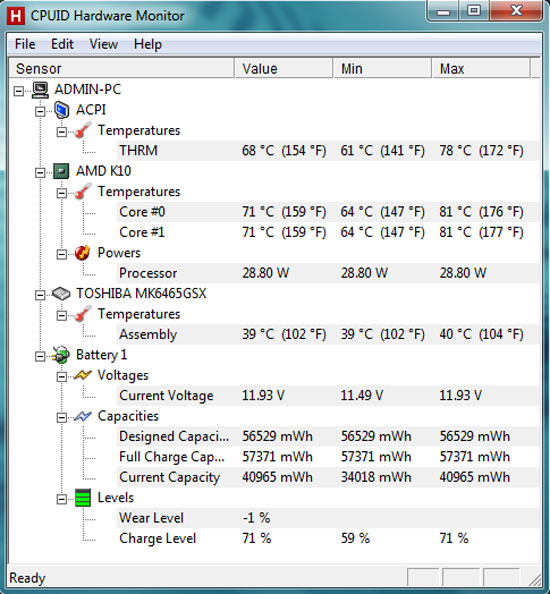
The processor temperatures are going to seem a little alarming, but they're not too far from where we've seen Arrandale-based notebooks hit. It may be better to look at the hard drive's temperature, which remains constant under both idle and load: 40C is perfectly reasonable. The L645D isn't in danger of overheating.
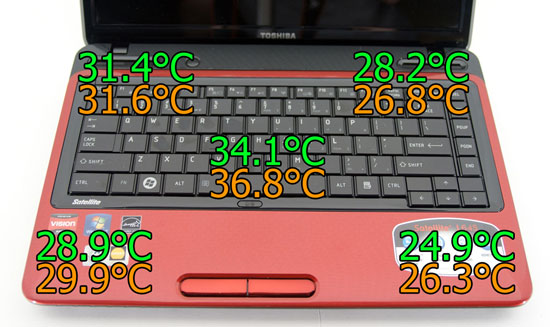
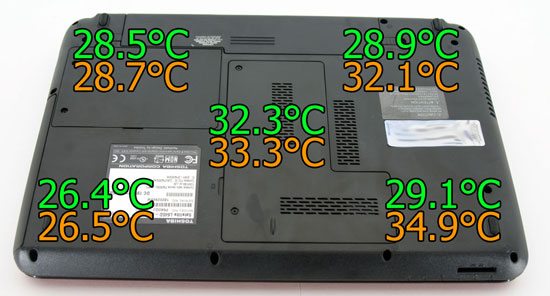
Idle and load surface temperatures are a little hotter than some of the other notebooks we've reviewed recently, but still nothing to complain about. Palmrests remain comfortably cool, as does the bottom of the notebook, with the center of the keyboard getting the hottest under sustained load. The central hot spot's 36.8C equates to roughly 100F, which is by no means cool but also not swelteringly hot either.
The L645D actually handles heat pretty well, and though the fan can definitely spin up noticeably under load, it's not aggravatingly loud and certainly not any louder than competing notebooks tend to be.










61 Comments
View All Comments
Dustin Sklavos - Wednesday, March 9, 2011 - link
Glossy plastic looks good in photos and that's about all it's good for; using glossy plastic for the keyboard is insane.mmatis - Wednesday, March 9, 2011 - link
I no longer touch any Toshiba products. Your mileage may vary.Vincent - Wednesday, March 9, 2011 - link
I see 10/100 ethernet offered on a surprising number of notebooks. Why cripple a machine like this? I wish reviewers would criticize manufacturers for not offering gigabit ethernet.alent1234 - Wednesday, March 9, 2011 - link
almost everyone uses wifi these days, and this is a way to cut some costs on a low margin product. most people won't care about no gigabit since no one has gigabit broadband and the whole home media server thing is a tiny nicheanactoraaron - Wednesday, March 9, 2011 - link
yeah but let's face it, we're talking about a difference of about a dollar to Toshiba for the gigabit upgrade. And to say whole home media server or even media sharing is a niche in regards to a laptop with a blu-ray player seems a bit off base.piroroadkill - Thursday, March 10, 2011 - link
No. If you want to use the laptops in a small business situation, imaging over gigabit is much, much faster.Believe me, consumer laptops DO get used in small business/education environments.
Also, gigabit ethernet would cost almost nothing to add over 10/100. There's simply no reason not to have it.
piesquared - Wednesday, March 9, 2011 - link
I recently bought an Acer 5552G with one an N660, and it's a terrific notebook. It has a 6470M but I never bought it for the gaming, even though it has no problems for what I use it for. Highly recommend the processors, and i'd wouldn't touch one of those flakey sand bridge things, or whatever they're called. It's a big risk buying one of those unstable and flawed parts.Kibbles - Wednesday, March 9, 2011 - link
I'm curious as to why glossy plastic is so adamantly deemed as bad, as if it's fact. I myself prefer the ultrafine matte that's almost like a paper texture, but that's a personal preference. I'm sure there's lots of people out there that like glossy plastics. I know my mom likes it. Could it be that the demographics that these low end laptops target predominantly prefer glossy plastics? Has any manufacturer ever given any statistical feedback on this?LoneWolf15 - Wednesday, March 9, 2011 - link
The amount of crap loaded on Toshiba laptops disguised as useful software makes me avoid them. Hey, we have a separate widget for managing absolutely everything, and each one runs in a separate process that takes up additional RAM, and each one is a separate executable that takes up disk space too! Isn't that NEAT?Toshiba, a bit of advice: Look at apps like Dell ControlPoint, or even a few of Lenovo's (not as cohesive, but still better thought-out), and realize what a great service you could do your users by bundling nearly a dozen system utilities into a single, unified app. That way, the average user doesn't have to send a system to me to figure out what is useful, what is not, and why all of the stock software is sucking half a gig of RAM (on top of what the OS takes) out of the box, and thrashing the disk. Actually, you're also less likely to have a user say "I'll never buy a Toshiba again, they're ungodly slow."
KiwiTT - Wednesday, March 9, 2011 - link
After nearly 8 years since that model was released, I would have thought we would have had double or even triple the resolution in a 14" form-factor.And it is not just Toshiba, it is nearly all the manufacturers. And if you want comparable resolution to the T41, you have to pay almost double. While you may say that the new notebooks have better brighter Screens, CPUs, Graphic Cards, Battery life, etc., it seems as if screen resolution has been stuck in neutral. This is the main portal to all that is available in the notebook, so it should be the best it can be.
I think major review sites like this one and others should actually start bemoaning this lack of increase in resolution for more mainstream notebooks. Even the new ipad2 was rumored initially to have a better resolution, but no, this was false again.